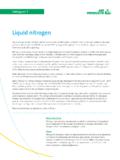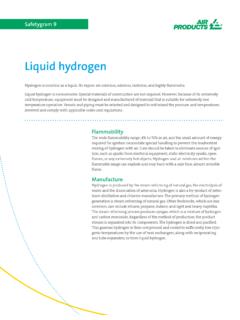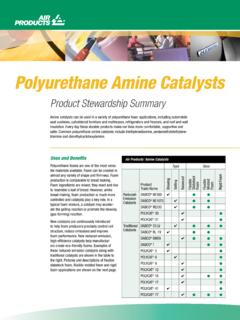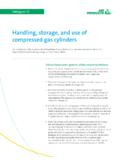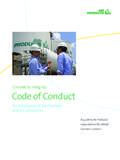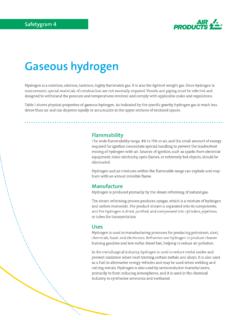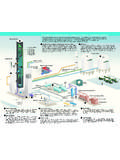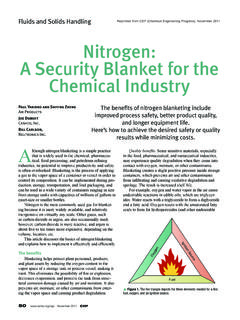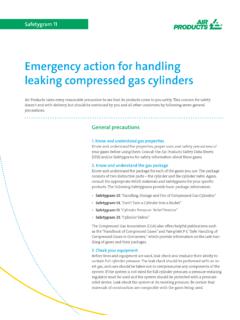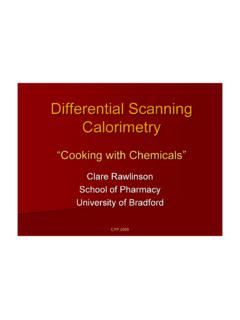Transcription of Introduction to Furnace Brazing - Air Products & Chemicals
1 Introduction to Furnace BrazingWhile every effort was made to ensure accuracy in the preparation of this publication, the material used to compile the information presented was derived from many different sources and intended to serve only as a general guide, and not as a handbook for specific applications. As such, Air Products and the members of its Editorial Review Board assume no responsibility for technical accuracy or omissions due to editing or printing Products Editorial Review BoardDr. Diran ApelianExecutive Director, CHTEMPIB ruce Boardman, FASMF ounding Member, CHTED eere & Fabian, FASMP resident, ASM Heat Treating SocietyBodycote-LindbergDan HerringDirector of TechnologyIpsen International, Nayar, FASMP residentTAT TechnologiesRobert PeasleeVice PresidentWall Colmonoy of ContentsIntroduction to Furnace Brazing .
2 7 Definition of Brazing ..7 History of Brazing ..7 Differences between soldering, welding, and Brazing ..7 Flame Brazing vs. Furnace Brazing ..8 Furnace configurations ..9A Look at Common Furnace Brazements ..11 Base metals ..11 Typical brazement parts/assemblies ..11 Joint design and preparation ..13 Types of joints ..13 Selecting a base metal ..14 Selecting a filler metal ..17 Pre-assembly and fixturing ..17 Wettability ..18 Considerations for Furnace Brazing ..19 Physical ..19 Metallurgical ..19 Furnace equipment.
3 20 Safety/environmental ..21 Furnace Brazing Technologies ..22 Controlled-atmosphere processing ..22 Vacuum Furnace Brazing ..29 Other Brazing technologies ..30 Troubleshooting ..31 Potential metallurgical problems ..31 Atmosphere-related problems ..33 Summary ..35 Glossary ..36 Bibliography ..391 Introduction to Furnace brazingWhat is Brazing ?The term Brazing can be applied to any process which joins metals (of the same or dissimilar composition) through the use of heat and a filler metal with a melting temperature above 840 F (450 C), but below the melting point of the metals being joined.
4 In Furnace Brazing , temperatures of 2050 to 2100 F (1120 to 1150 C) and above are not uncommon, especially when Brazing stainless steels with nickel-based filler metals or carbon steel with copper filler metal . Other very high temperature Brazing applications include molybdenum with pure nickel as the filler metal and cobalt with a cobalt alloy filler successfully brazed joint often results in a metallurgical bond that is generally as strong or stronger than the base metals being joined. Modern Brazing technology has extended the definition to include the bonding of metal to non-metallic substrates, including glass and refractory materials.
5 However, this publication is limited to Brazing of metals only, and, specifically, Furnace Brazing of courtesy of Handy & HarmanFigure 1: Eyeglass frames showing sequence of Brazing operationsHow does Brazing join materials?In Furnace Brazing , the parts or assemblies being joined are heated to the melting point of the filler metal being used. This allows the molten filler metal to flow via capillary action into the close fitting surfaces of the joint and to form an alloy of the materials at the transition point upon solidification.
6 The base metals do not melt, but they can alloy with the molten filler metal by diffusion to form a metallurgical the metallurgical properties at the brazed joint may differ from those of the base metals, the selection of the appropriate filler metal is critical. Depending on the desired properties of the application, the Brazing operation can be used to impart a leak tight seal and/or structural strength, with excellent appearance characteristics, in addition to joining for the purpose of extending section length, , in piping or tubing history of brazingBrazing is the oldest method for joining metals, other than by mechanical means.
7 Initially, the process was most popular for joining gold and silver base metals. Lead and tin, as well as alloys of gold-copper and silver-copper, were used as filler metals because of their low melting points . Copper hydrates and organic gums were added later because of their reducing action, which helped to minimize oxidation and improve the cosmetic appearance of the joint. Metallic salts were also , alloys of brass and copper were introduced as filler metals because of their ability to produce higher-strength joints in copper and steel structures, which were also able to withstand high temperatures.
8 As Brazing technology advanced, many other filler metals have between soldering, welding, and brazingThe joining techniques of soldering, welding, and Brazing have many similarities; however, each process has its own characteristics and specific indications for use. Generally, the criteria for selecting one process over the other depend on the physical and economic requirements of the base metals and/or end-use of the assembly being with Brazing , soldering does not involve the melting of the base metals.
9 However, the filler metal used has a lower melting point (often referred to as liquidus ) than that of Brazing filler metals (below approximately 840 F, or 450 C) and chemical fluxes must be used to facilitate soldering operations, heat may be applied in a number of ways, including the use of soldering irons, torches, ultrasonic welding equipment, resistance welding apparatus, infrared heaters, or specialized ovens. A major advantage of soldering is its low-temperature characteristic which minimizes distortion of the base metals, and makes it the preferred joining method for materials that cannot tolerate Brazing or welding temperatures.
10 However, soldered joints must not be subjected to high stresses, as soldering results in a relatively weak , on the other hand, forms a metallurgical joint in much the same way as Brazing . Welding filler metals flow at generally higher temperatures than Brazing filler metals, but at or just below the melting point of the base metals being are often employed to protect and assist in wetting of the base- metal surfaces. Heating sources include plasma, electron beam, tungsten and submerged arc methods, as well as resistance welding and, more recently, laser-based equipment and even explosive disadvantage of welding is its requirement for higher temperatures, which melts the base metal at the joint area and can result in distortion and warpage of temperature-sensitive base metals and stress-induced weakness around the weldment area.
